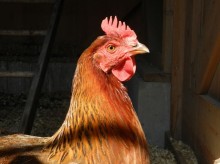Problem 1: Chickens need to get plenty of fresh air and exercise. They need soft dirt to scratch in. They do best on a varied diet that includes greens and bugs. In the summer they need shade and cool earth to lie in. But, I can’t let my hens out to free-range unless I’m watching because of hawks that live nearby. So, for much of the day my chickens are confined to a packed-dirt pen. It’s not optimum.
Problem 2: Every day, I fill a bucket with scraps from my kitchen endeavors. There are onion peels, stale bread and carrot scrapings, coffee grinds and desiccated oranges. Some of it the chickens eat (like tomato cores) and some they don’t (like banana peels.) If I toss it all to the hens, the entire run would soon be a mess of molding food. How to feed the chickens the worthwhile bits without sorting through these dregs? I don’t want to have two compost buckets on my kitchen counter. I have other stuff to compost, too, including weeds and damaged vegetables from the garden, and the muck and trampled on hay from the goat stall. There’s a lot of material from different sources, but I don’t want to fuss with it. I want one easy pile.
Two problems, one solution: build a compost bin in the chicken run. The hens will eat what they like, and shred everything else into little bits. In the summer it becomes a cool, damp respite from the heat. In the winter I use my judgement. If there’s snow cover I don’t put the compost out. It only works if the hens are able to get in it and scratch. You don’t want it to become pile of frozen garbage. But, there are plenty of days in the winter when the hens are happy to have compost to work in. All year long, this method of turning waste into compost is barely any effort for me – the chickens do all of the work of mincing the material and turning it over. Soon enough, it decomposes, shrinks in size, and it turns into good garden soil.
Since I have separate flocks of hens in two barns, I have two compost piles. In the Little Barn’s run there’s an area off to the side of the coop that was easy to turn into a compost heap. I’ve put a sturdy piece of fencing blocking it off, but left openings on both sides. The two exits ensure that the hens don’t get trapped in a corner or bullied and the fencing keeps the compost from being kicked by chicken feet into the rest of the run.
In the Big Barn run, using metal fence posts and chicken wire, we built a compost that forms the letter C. It’s round shape keeps the hens from getting hassled by aggressors. The girls go in and out easily, and yet it keeps the materials contained so that the rest of the run stays tidy. I’ve tried bins made from pallets, but the hens liked roosting on top and then escaping out of the pen. They don’t like to sit on thin chicken wire.


